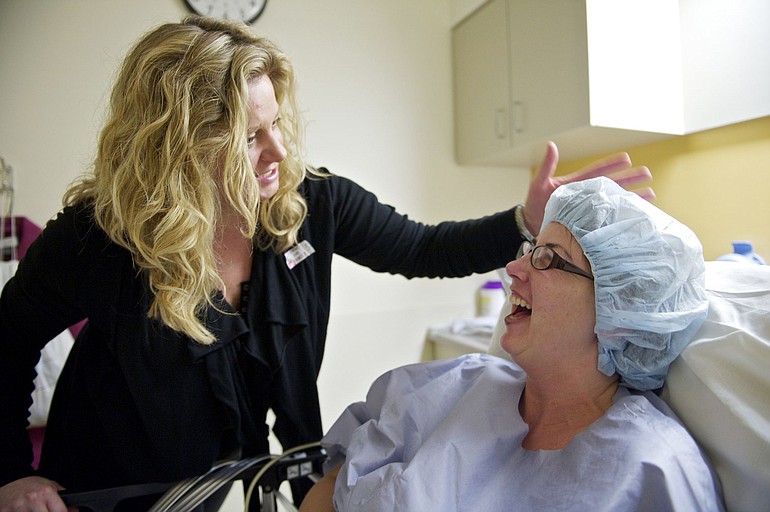Follow Krista Colvin through her journey in the series: “Coping with Cancer“
To prepare for her TV appearance on KATU’s AM Northwest, Krista Colvin sprays and styles her hair to make it look full.
It’s not full. It’s falling out.
This is the 43-year-old Camas resident’s first TV appearance since she was diagnosed with an aggressive form of breast cancer in March. She serves as a lifestyle expert for the show, appearing regularly to talk about organization, which she has made her business. This time, she will talk about how to support a loved one with cancer. It will be her cancer coming-out, so to speak.
She grooms gingerly, trying to protect the hair left on her head. But she pulls out a disconcerting amount in the process.
Her coif holds, however. When the camera rolls, she clicks into TV mode.
“You look great,” AM Northwest host Dave Anderson says. “How do you feel?”
A loaded question. The answer changes by the moment. For the purposes of the show, Krista keeps it simple.
“I’m not 100 percent.”
About five weeks before, Krista reports to Southwest Washington Medical Center to have a port inserted in her chest, where she will receive infusions of chemotherapy. It’s another one of those appointments that she downplays and then realizes is a big deal. This time, though, she has a friend with her. Dana Bell sits next to the bed as Krista awaits surgery. Krista’s thirsty, but she can’t drink anything before the procedure. A nurse brings her a moist sponge on a stick to run over her tongue.
The surgeon, Dr. James Kilway, pops in to explain the procedure before they head to the operating room. Then they discuss her course of treatment. Doctors have identified one tumor about 3 centimeters around, but there’s another spot in her breast that hasn’t been tested yet. Kilway tells Krista that if that spot is also cancer, he would not recommend removal of just the tumors, but the whole breast.
Krista has already thought about that. She wants to remove both breasts to eliminate the risk that she’ll develop cancer in the remaining one.
“I’m comfortable if they need to go,” she says. She breast-fed her two children. “They’ve done their thing.”
Mastectomy would come after chemotherapy, which is imminent. While Krista sounds blasé when she talks about mastectomy — maybe because it’s months away — she’s finding it harder to face chemotherapy.
Krista can’t bring herself to look into the chemo room lined with recliners when she reports to Northwest Cancer Specialists to see her oncologist, Dr. Kathryn Kolibaba.
Kolibaba has outlined a plan for two 12-week rounds of chemotherapy, the second of which will be the most taxing on Krista’s body. It will include the drugs 5FU, Epirubicin and Cytoxan.
In the first round, Krista will receive taxol and Herceptin. Taxol is derived from yew trees. Herceptin is the drug that gives Krista the most hope, however. She will receive it for an entire year.
Herceptin targets cancer that’s fueled by human epidermal growth factor receptor 2, also known as HER2. It’s an aggressive form, and it had already reached Krista’s lymph nodes. Herceptin is an antibody that attaches itself to the cancer cell and signals the body’s immune system to attack it.
In studies, breast cancer was half as likely to come back in patients who received Herceptin than in patients who received chemotherapy alone. Some of Kolibaba’s patients participated in clinical trials in 2003.
“It’s a fabulous breakthrough,” Kolibaba says.
Before Krista starts the treatments, she takes a class on what to expect.
The nurse runs through the side effects and how to cope with them, as well as the importance of exercise and a good diet.
When she mentions that after hair loss, wearing a hat to bed will keep the head warm, Krista matter-of-factly tells Dana, who has accompanied her, to add a skull cap to her shopping list.
Then the nurse tells Krista she’ll probably start losing hair a few weeks into the first round of chemo. Dana tears up. Krista starts crying.
“I thought that wasn’t until my second round,” she says. She’s upset not out of vanity, she tells the nurse. “It’s more to prepare my kids.”
She and her husband, Mike, want to protect their children from what Krista is going through. They try to spend quality time as a family and keep the kids on their routines.
One evening before Krista begins chemotherapy, she and Mike want the kids to stay at the table to visit after they’re through eating.
Wes, 10, plops on the couch, not far from the table in the family’s great room, but his attention is on the TV.
Mike commands him back to the table. Wes balks.
How could he understand what’s at stake?
Mike tries to explain it to his son later that night: “I’m asking this because later on you’re going to thank me.”
Mike tosses and turns the night before Krista’s first treatment, and she can’t sleep either. But when she arrives at the clinic, she’s ready. She has a bag with her clipboard, netbook, iPhone, magazines, blanket and hard candy. She sits back and closes her eyes as the nurse hooks her port to a line leading to bag of clear fluid, the first of several drugs she receives. In addition to the Herceptin and taxol, Krista gets an antihistamine to lessen the chance of an allergic reaction and steroids to counter nausea.
Even then, as the drugs drip into her body over the course of four hours, it’s still hard for Krista to believe she has cancer.
It’s hair that splices through the disbelief. A few days after her fourth weekly treatment, strands clog the drain after a shower. They coil in her brush after she runs it through her hair. They linger on her pillow.
She still has hair. Just less.
And less.
And less.



